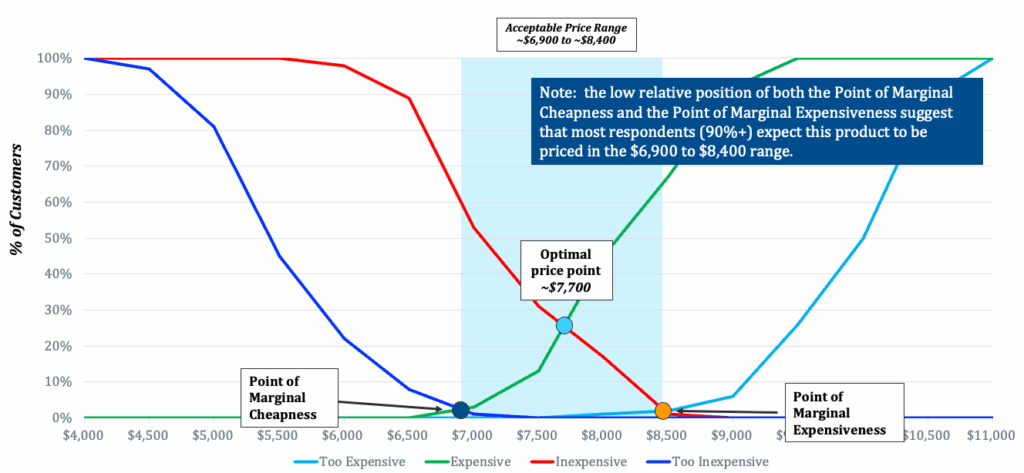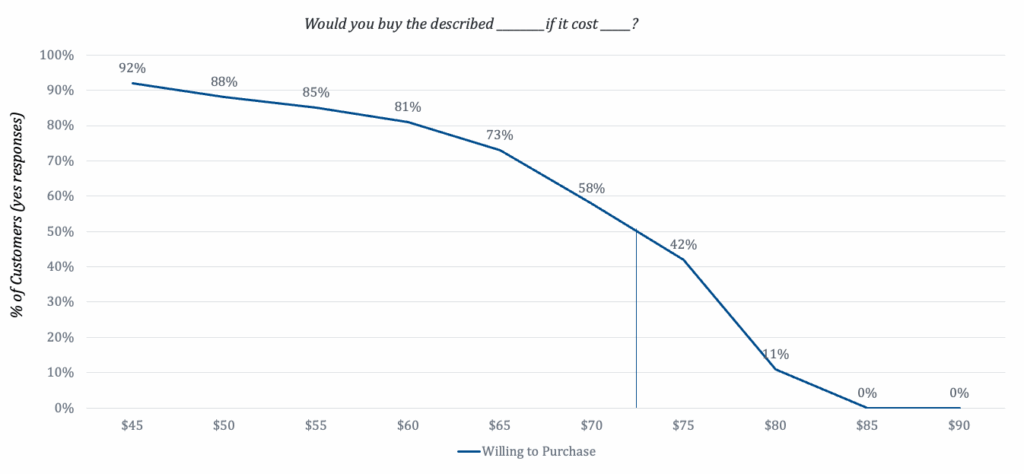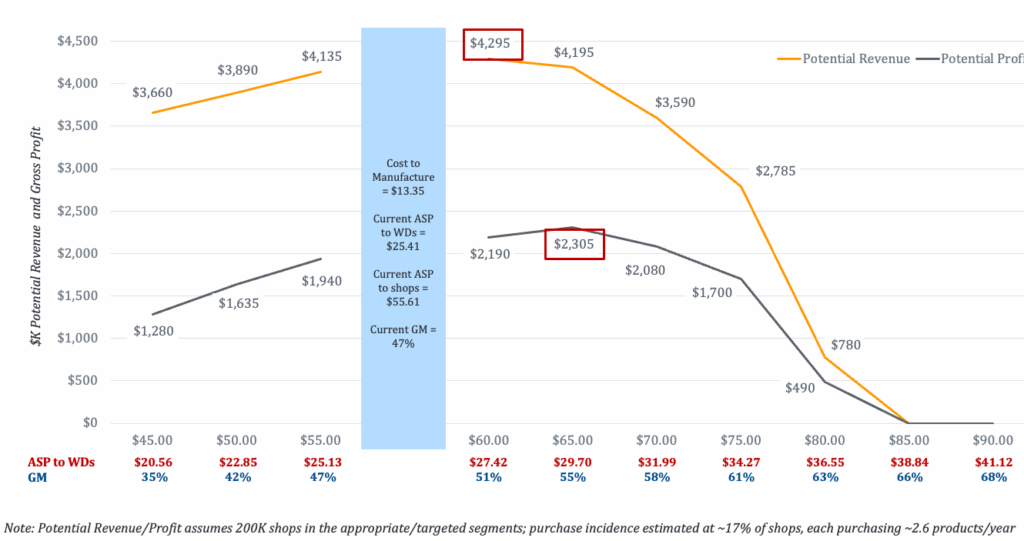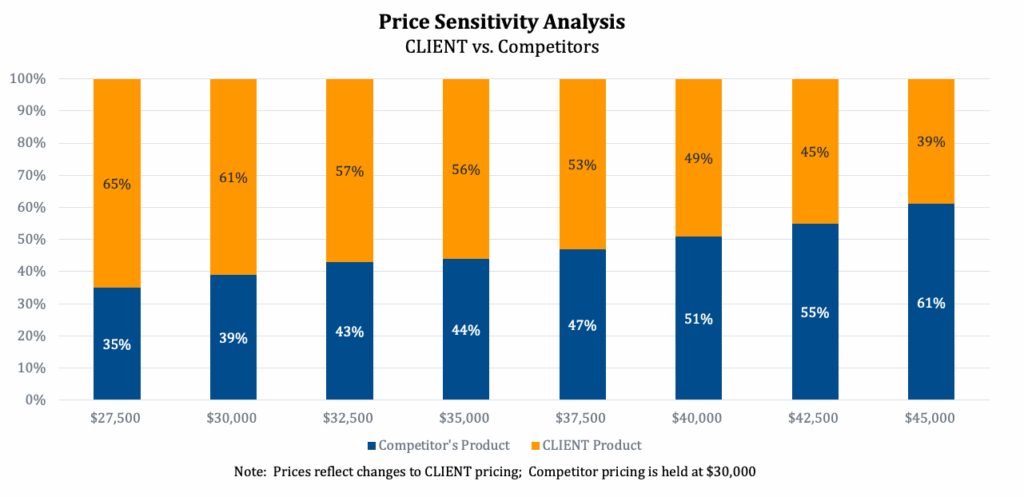By Ken Donaven, Partner
Price Sensitivity research explores how customer demand or willingness to purchase shifts in response to changes in price. While the term is often used interchangeably with price elasticity, it’s helpful to distinguish the two:
- Price elasticity is a strict economic formula: the percentage change in demand divided by the percentage change in price. It is observable data that shows trends and directional movement.
- Price sensitivity, as studied in market research, refers more broadly to how customers’ purchase intent changes when price points vary.
For most organizations, understanding price sensitivity is less about formulas and more about generating practical, data-driven insights. These insights help determine acceptable price ranges, evaluate the impact of proposed changes, and guide feature-specific or competitive pricing strategies.
Why Measure Price Sensitivity?
Organizations turn to price sensitivity research for several reasons:
- To assess the likely impact of price increases or decreases on demand
- To identify the maximum price customers are willing to pay while still making a purchase
- To evaluate the price potential of new product features or upgraded offerings
- To validate proposed price changes before going to market
- To ensure pricing decisions optimize not just revenue, but also profit margin
Key Methodologies for Price Sensitivity
A variety of research techniques can be used to assess price sensitivity, many of which have been explored and defined throughout this series. Each has strengths, limitations, and best-use scenarios.
1. Monadic Price Testing
In Monadic testing, survey respondents are shown a single price point and are asked whether they would purchase at that particular pricing level. To test three different prices, researchers must use three discrete samples.
- Strengths: Monadic price testing is a straightforward and “pure” way to measure purchase intent at fixed prices.
- Limitations: It, by rule, requires large sample sizes to achieve reliable results, which is often impractical in business-to-business contexts.
Because of its sample size demands, Monadic testing is less commonly used in commercial due diligence or B2B pricing work.
2. Van Westendorp Price Sensitivity Meter
A staple in pricing research, the Van Westendorp methodology asks respondents four questions such as:
- At what price is the product so cheap you would doubt its quality?
- At what price is it inexpensive but still acceptable?
- At what price is it expensive but still worth considering?
- At what price is it too expensive to purchase?
Overlaying these responses produces a set of curves that reveal both an optimal price point and an acceptable range of prices.

- Strengths: Van Westendorp is relatively simple to administer and widely recognized as a tried and true methodology.
- Limitations: Respondents have a tendency to overstate what they would pay when being surveyed, which can mean that the results are better understood as aspirational rather than predictive.
Taking this analysis one step further, we can use the “expensive but still a possible purchase” price point as a rudimentary WTP analysis. By adding a likelihood-to-purchase question at that identified price point, Martec can estimate potential demand and build revenue curves based on real-world customer insights and preferences:
- How likely are you to purchase at the “expensive but still possible” price?
This additional data context allows researchers to create demand curves that better link perceived value to actual purchase intent.

3. Gabor-Granger Pricing
A Gabor-Granger study builds on the Monadic testing methodology by asking each respondent about multiple prices within a predefined range. If a respondent says “yes” to one price, they are asked about higher prices until they say “no.” Conversely, if they say “no,” the next lower price is tested, and so on, until the respondent replies “yes.” This provides a “willingness to purchase” that identifies the “tipping point”; the price at which less than 50% of respondents are willing to purchase the product

- Strengths: A Gabor-Granger study identifies the maximum price point at which each respondent would purchase a given product. It results in the ability to produce revenue curves that highlight not only where revenue is maximized but, with cost inputs, where profit is maximized.
- Limitations: Gabor-Granger is still a survey-based methodology, so stated preference may not always match actual market behavior, as noted above with respect to Van Westendorp studies.
In practice, Gabor-Granger results can be paired with a company’s internal cost-to-manufacture and channel margin data to reveal how far companies can push pricing while protecting or enhancing profitability.
Illustrative Example: Maximizing Profit vs. Revenue
Hypothetical Business Challenge:
Let’s say a manufacturer of machinery wants to test a new product that will offer additional features. Leadership needs to know not only what customers would pay, but whether the new pricing strategy would, in fact, increase margins and profitability.
Approach:
- You might start with a Gabor-Granger study (like that shown above) to assess Price Sensitivity for a product across a price range from $45 to $90.
- You would then pair those survey results with cost-to-manufacture and channel pricing data obtained from internal sources.
- You could then calculate and model revenue and profit curves at each price point in that range.

Findings:
- In this case, the research revealed that revenue would be maximized at $60, the price ~80% of purchasers would be willing to pay”
- However, profit peaks at $65—a higher price point, with a lower willingness to pay – but one that delivers a higher overall gross margin relative to cost.
Outcome:
Armed with both perspectives, the manufacturer set pricing at $65. The decision balanced market acceptance with margin growth, resulting in higher total profitability than a revenue-maximization strategy alone.
4. Conjoint Analysis
Conjoint analysis has evolved to become perhaps the most sophisticated way to study price sensitivity, especially in competitive contexts. In a choice-based conjoint exercise, respondents evaluate product options with varying feature and price combinations and provide feedback on their preferences for various combinations of feature and price point.
- Strengths:
- Conjoint captures trade-offs customers evaluate in realistic scenarios and how those considerations impact willingness to pay (or not).
- It also allows one to run models to illustrate how competitors’ pricing moves could affect a customer’s or market’s “share of preference.”
- Beyond real-world data and insights, Conjoint modeling supports simulations of next-generation products with new features, even if they haven’t been introduced into the market, been manufactured for testing, or perhaps even prototyped. You can actually test pricing sensitivity prior to investing time and resources into prototyping or manufacturing.
- Limitations: Conjoint can be more complex to design and analyze than simpler approaches examined above.
Importantly: By running sensitivity analyses across multiple configurations, Conjoint analysis reveals how demand shifts at different price levels—not just in isolation, but in the context of competition.

Practical Considerations for Pursuing Pricing Sensitivity Analysis
Regardless of methodology one pursues to inform or validate pricing strategy, several themes emerge:
- B2B sample constraints: Many methods that work well in consumer markets (like Monadic testing) are less feasible when audience sizes are limited, as they typically are in B2B sectors.
- Revenue vs. profit trade-offs: Keep in mind the price point that maximizes revenue may not maximize profit. Sensitivity analysis must account for a host of variable cost structures and influences that impact profit, discrete from how they impact revenue alone.
- Competitive dynamics: Price moves rarely happen in a vacuum. Effective research incorporates “what if” scenarios that reflect potential competitor responses.
Practical Applications of Price Sensitivity Research
Organizations use Price Sensitivity studies to:
- Test the market impact of price increases before implementation.
- Assess whether new product features justify premium pricing.
- Align channel pricing with end-customer willingness to pay.
- Understand both “floor” (credibility thresholds) and “ceiling” (drop-off thresholds) price points.
The insights gleaned from Pricing Sensitivity research provide a foundation for making informed decisions, ensuring that pricing strategies optimize profitability while protecting competitive position.
Key Takeaways:
Price Sensitivity research equips organizations with the tools to balance customer expectations, competitive dynamics, and financial performance. While methodologies vary in complexity—from simple Van Westendorp surveys to more sophisticated Conjoint simulations—they all serve a common purpose: reducing guesswork and grounding pricing decisions in data-based evidence.
The key insight to absorb is there is no single “right” method. Instead, the approach proscribed depends on the research question, the available sample, and the strategic objectives. When applied correctly, Price Sensitivity analysis doesn’t just identify acceptable ranges; it illuminates the trade-offs between revenue and profit, highlights competitive risks, and validates whether proposed price changes or new features will succeed in the market.
In short, Price Sensitivity research ensures pricing strategies are not only defensible but also optimized for long-term growth.
Ken Donaven is a Partner with The Martec Group. He can be reached at Ken.Donaven@martecgroup.com. If you would like to explore how Brand Mapping can help clarify your value proposition, uncover performance gaps, and chart a course for growth, please don’t hesitate to reach out.
The post Understanding Customer Price Sensitivity to Validate or Inform Pricing Strategy appeared first on Martec.